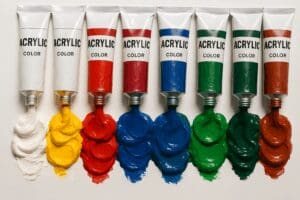Crackles are the fine veins that may or may not be coloured; running through the outlines or certain areas of design in a piece of batik. It was once considered a sign of inferior batik in the olden days, especially on indigo coloured batik but acceptable on brown batik. However, it has evolved to be a much appreciated characteristic associated with fine handmade batik.
This particular effect is rendered through folding, crushing, freezing or utilising any method that breaks up an area or the outlines of uninterrupted dried wax in the design. It happens before placing the cloth in the last dye bath. By doing so, the crackle that is synonymous with handcrafted batik is produced.
A mixture of waxes is the core of such an effect; usually consisting of beeswax and paraffin. Beeswax is malleable, thus functioning by regulating the flow; and paraffin for its brittleness. Paraffin is never used on its own as it does not cling to the cloth well. Besides that, the key is controlling the amount of paraffin in order to achieve the amount of veins the artist wishes to attain. The more paraffin is used, the more cracks would appear and vice versa. Traditionally, resins such as the residue of pine-gum distillation (known as gondorukem in Malay) and cat’s-eye resin (damar mata kucing) are used to increase the ability of the wax mixture to adhere to the cloth. Animal fat such as tallow is also added to liquefy the solution.
Some artists may prefer to use microwax (microcrystalline wax) as a replacement for beeswax or even add it to the mixture. Even though both microwax and paraffin are by-products of crude oil distillation, microwax is darker, stickier and denser than paraffin. It is also more elastic, hence making it a suitable choice to replace beeswax.
A recent trend has emerged whereby soy wax is used instead of the conventional beeswax and paraffin. It attracts artists because:
· It has a low heating point (130°-150°F/54°-66°C) which reduces the risk of burns.
· It burns clean, thereby emitting no toxic fumes.
· Due to its low heating point, it is washed out with hot water or warm water and synthrapol, thus eliminating one of the more laborious steps in batik making.
· The crackle effect can be done without the need to create a wax mixture.
How is this effect achieved?
-
- A mixture of waxes, usually beeswax and paraffin; are melted in a crock pot or any wax melting device.
-
- The dyes (in this case, powder dyes are used) are prepared for the next process; along with sodium alginate to improve viscosity and soda ash to make the colour more permanent.
-
- Each colour of the powdered dyes are put in separate containers and then mixed with hot water.
-
- The cloth is stretched on a board and the design is drawn using a pencil or as shown in the picture, a Frixion pen. This pen uses a type of heat-sensitive ink that will disappear upon contact with heat.
-
- Areas to remain white are brushed with the melted wax. Then, the picture is coloured with the prepared dyes. The dye must be dried completely before the next step is taken.
-
- Wax is brushed over areas where the colours are are to be preserved. In the picture, the dark spots are areas which are unwaxed.
-
- Scrunch the cloth to crack the wax.
-
- The cloth is then submerged in a black dye bath.
-
- Using an old iron, the cloth is then ironed between sheets of newspapers to remove the wax. The newspaper sheets are to be replaced frequently.
- It is done!
Source by Sarah Yeoh
Disclaimer: The views and opinions expressed in this article are those of the authors and do not necessarily reflect the official policy or position of Irish Artmart.





